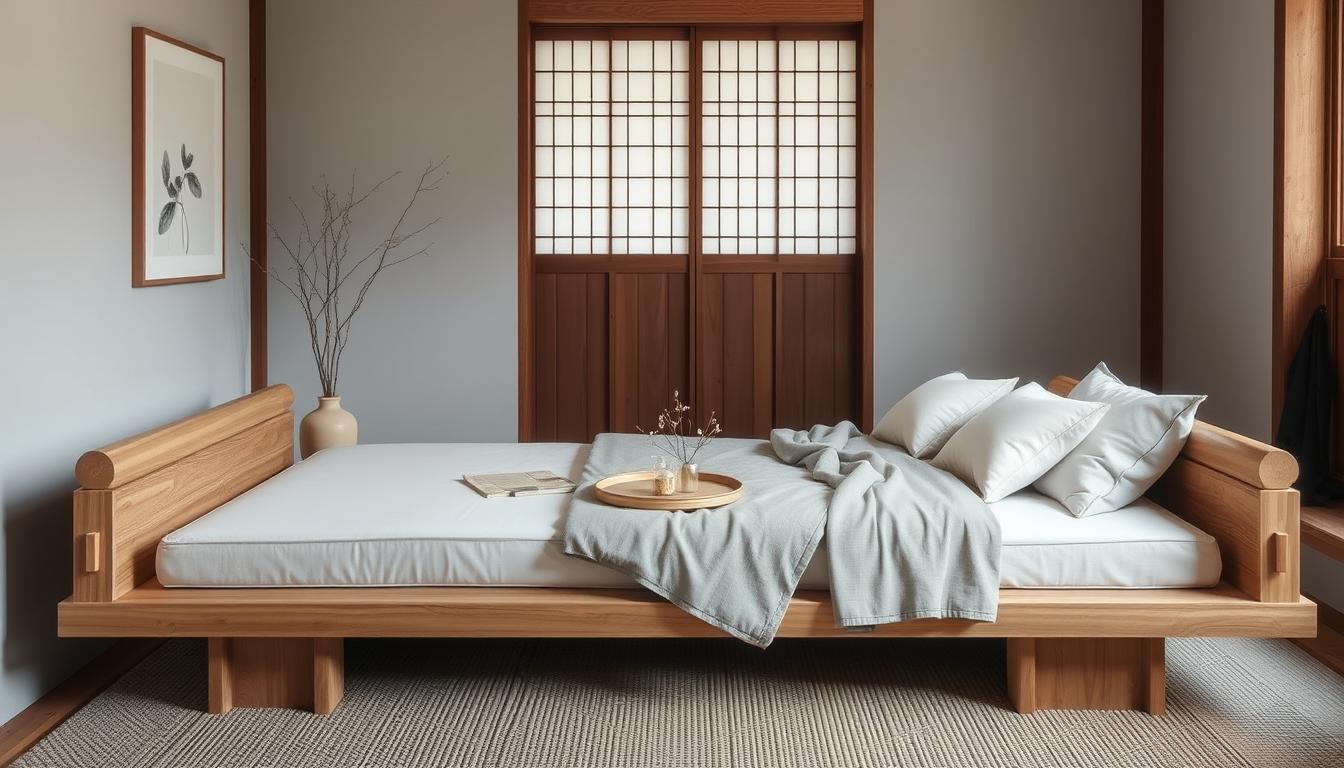
Daybed modern style japanese blend comfort and style in a unique way. They combine Scandinavian functionality with Japanese minimalism for a fresh design approach. These daybeds can turn your living space into a peaceful, elegant sanctuary.
Japandi daybeds are more than just furniture; they’re a lifestyle choice. They embody simplicity and natural elements, creating balance in your home. With clean lines and practicality, these daybeds maximize space without sacrificing style.
Japandi design shines through its use of natural materials. Solid wood frames and organic textiles boost visual appeal and sustainability. By using these elements, you’re creating a space that promotes well-being and calm.
Key Takeaways
- Japandi daybeds blend Scandinavian and Japanese design principles
- Minimalist design and clean lines are key features
- Natural materials like wood and organic textiles are essential
- Multifunctional capabilities make them perfect for small spaces
- Neutral color palettes and textural contrasts enhance visual appeal
Understanding Japanese Design Philosophy in Modern Interiors
Japanese design philosophy blends simplicity and functionality in modern interiors. It creates spaces that are beautiful and practical. This approach stems from Zen aesthetics, making it appealing in today’s homes.
Principles of Zen Aesthetics
Zen aesthetics focus on creating calm, balanced environments. Japanese interiors feature neutral color palettes with earthy tones. They use natural materials like wood and bamboo.
Minimalist decor avoids clutter in these spaces. Diffused lighting through paper screens (shoji) adds a soft ambiance.
- Neutral color palettes with earthy tones
- Natural materials like wood and bamboo
- Minimalist decor that avoids clutter
- Diffused lighting through paper screens (shoji)
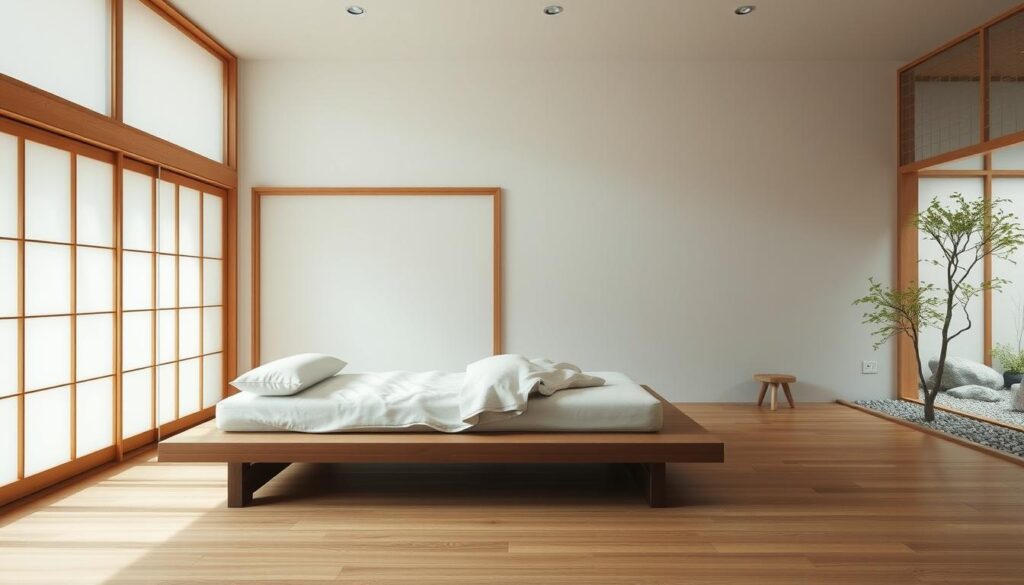
Balance of Form and Function
Japanese design combines beauty with practicality. This approach is seen in multi-purpose rooms that maximize space. Low-profile furniture creates a spacious feel.
Built-in storage maintains a clutter-free look. Sliding doors create flexible living areas.
- Multi-purpose rooms that maximize space
- Low-profile furniture for a spacious feel
- Built-in storage to maintain a clutter-free look
- Sliding doors to create flexible living areas
Minimalist Approach to Space
Japanese minimalism creates serene, uncluttered spaces. It uses only essential furniture pieces. Empty space (ma) is incorporated throughout the design.
Quality is chosen over quantity in decor. Nature is brought indoors with plants and views.
- Using only essential furniture pieces
- Incorporating plenty of empty space (ma)
- Choosing quality over quantity in decor
- Bringing nature indoors with plants and views
Use these ideas to create a modern interior. It will reflect the timeless elegance of Japanese design philosophy.
Daybed Modern Style Japanese: Essential Elements and Features
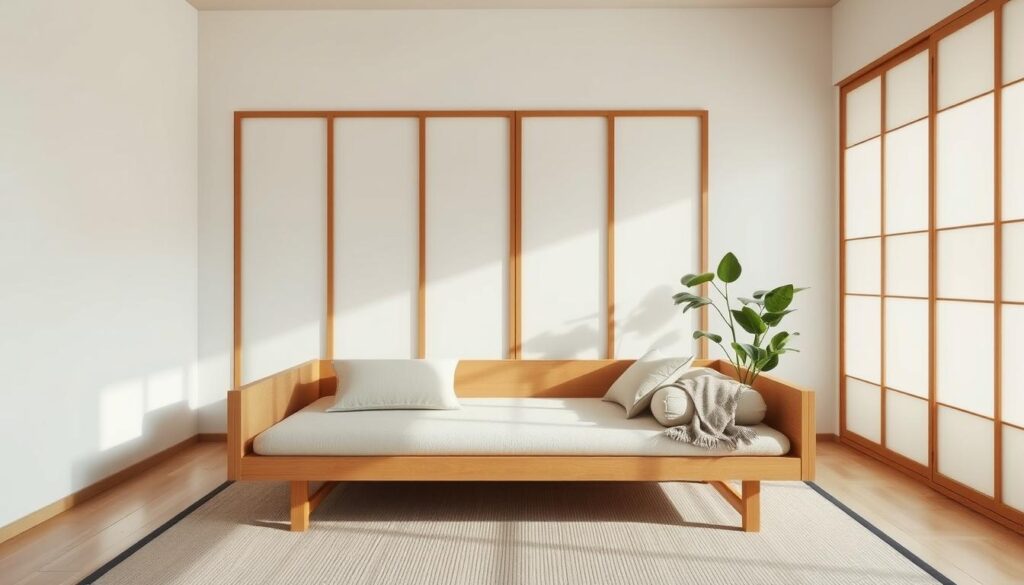
Modern Japanese daybeds mix simplicity, elegance, and practicality. They offer a perfect solution for minimalist living. Clean lines and understated design create a serene atmosphere in any room.
Space-saving is key for these daybeds. Their low-profile design suits small apartments or multipurpose rooms well. They easily switch from cozy seating to comfortable sleeping space.
Versatility is a hallmark of Japanese daybed design. These multifunctional pieces adapt to various needs, serving as:
- A relaxation spot
- A guest bed
- A workspace
- A meditation area
Natural materials are crucial in modern Japanese daybeds. Solid wood frames, often oak or walnut, provide durability and appeal. Organic textiles like cotton and linen add comfort and texture.
These daybeds usually feature neutral color tones. Subtle hues create a calming environment for unwinding. By using a Japanese daybed, you embrace minimalist living principles.
This furniture helps create a clutter-free, tranquil space in your home. It combines form and function seamlessly. Japanese daybeds offer both style and practicality for modern living.
Incorporating Natural Materials in Japanese Daybed Design
Japanese daybed design brings nature indoors, creating a serene space. Natural materials align with Zen principles, fostering harmony. Let’s explore how to add these elements to your daybed room.
Wood Selection and Significance
Natural wood is key in Japanese daybed design. Oak and teak are popular for durability and warm tones. These woods age well, developing a rich patina over time.
When choosing wood for your daybed frame, pick sustainably sourced options. This supports eco-friendly practices and enhances your design’s authenticity.
Bamboo and Rattan Applications
Bamboo furniture adds elegance to your daybed space. It’s light yet strong, making it great for various uses. Try bamboo side tables or room dividers to complement your daybed.
Rattan brings texture to accessories like lampshades or storage baskets. Its woven look adds visual interest and a natural feel.
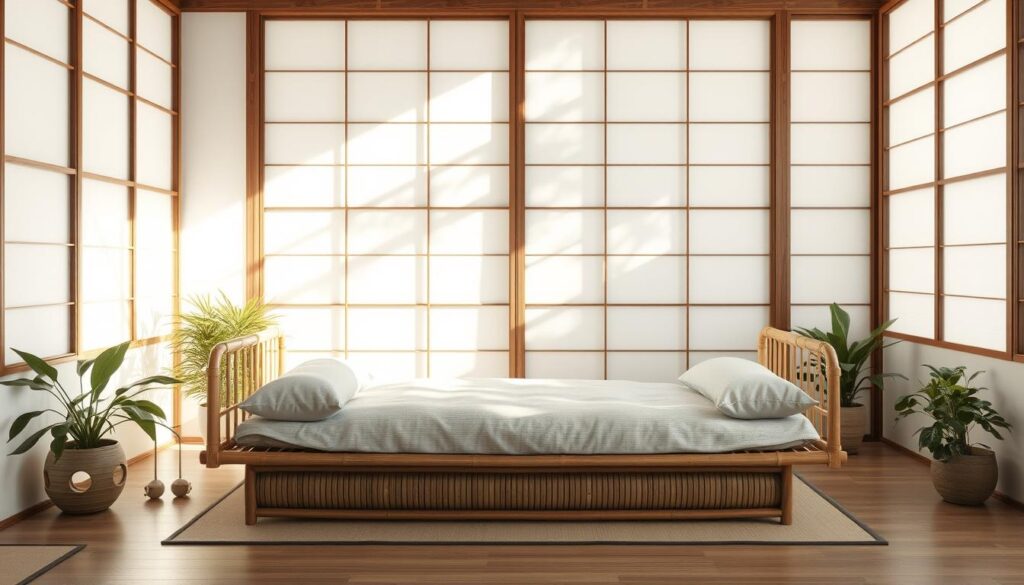
Organic Textile Choices
Organic textiles create a cozy, inviting daybed area. Linen and cotton work well for upholstery and bedding. These fabrics are breathable and comfortable, maintaining a natural look.
Choose neutral tones like beige, cream, or soft gray. These colors help create a calming atmosphere in your space.
Natural elements can transform your space into a peaceful retreat. Wood, bamboo, and organic textiles create harmony. This environment promotes relaxation and well-being.
Space Planning and Room Layout Considerations
Smart space planning is crucial when designing a room with a Japanese daybed. Japanese design embraces small space living, perfect for compact areas. You can create multifunctional rooms that serve various purposes.
Open-plan living is central to modern Japanese interiors. Removing unnecessary walls creates a sense of spaciousness and flow. This approach aligns with Japanese minimalism, allowing for a clutter-free environment.
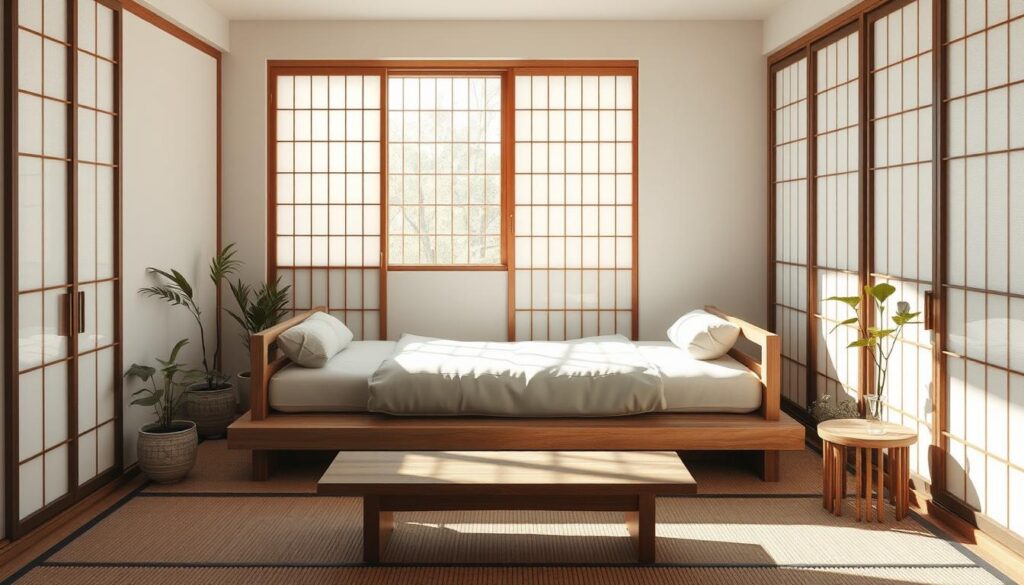
- Place the daybed against a wall to free up floor space
- Use low-profile furniture to maintain an open feel
- Incorporate storage solutions beneath the daybed
- Create zones within the room for different activities
These guidelines help create a versatile space embodying Japanese design. Many homeowners appreciate its focus on simpler living and natural materials. Integrating Grecian pillars can add a unique touch to your Japanese-inspired room.
Strive for balance between functionality and aesthetics. With careful planning, your Daybed Modern Style Japanese room can become a tranquil oasis. It will adapt to your daily needs while maintaining a serene atmosphere.
Color Palettes and Textures in Japanese Daybed Rooms
Japanese daybed rooms mix simplicity and sophistication. The right colors and textures create a calm space. Let’s look at how to make a serene room with Japandi design.
Traditional vs Contemporary Color Schemes
Neutral colors are key in Japanese daybed rooms. Whites, beiges, and soft grays make a peaceful backdrop. These colors reflect light, making rooms feel open.
For a modern look, add muted earth tones. Sage green or terracotta can bring life to the space.
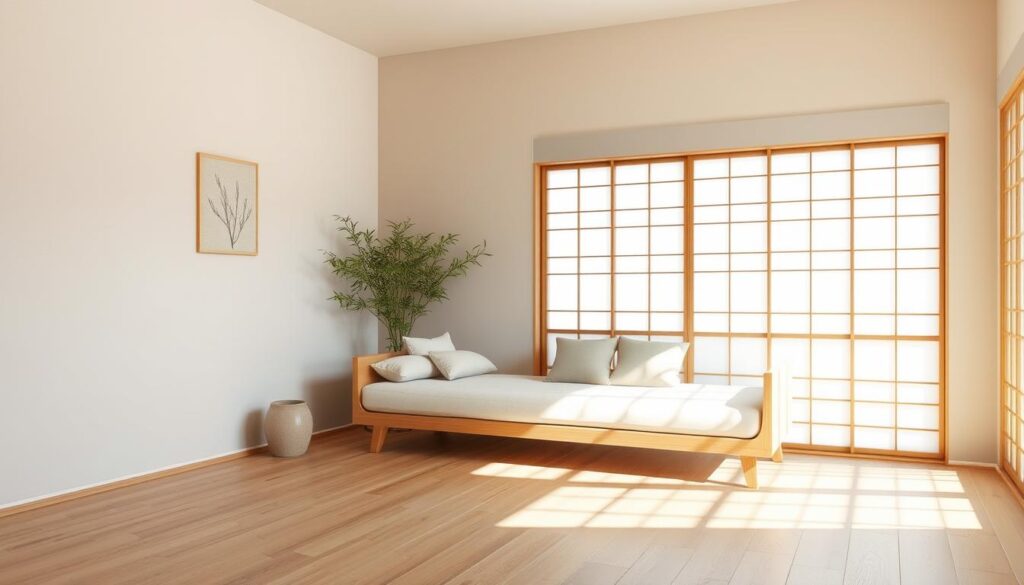
Textural Elements and Their Impact
Texture adds depth to your room. Mix smooth and rough surfaces for visual interest. A sleek wooden daybed with a nubby wool throw looks inviting.
Natural materials like rattan and bamboo bring warmth to your space. They add character and a cozy feel.
Creating Visual Harmony
Balance different elements for visual harmony. Use various textures but keep the overall color scheme simple. Add organic shapes in decor to soften the look.
In Japanese design, less is more. A clutter-free space helps you relax and feel calm.
- Choose furniture with clean lines
- Use natural fabrics for bedding and upholstery
- Add plants for a touch of nature
- Incorporate subtle patterns in textiles or artwork
Focus on neutral colors and textures to create a stylish Japanese daybed room. This design approach ensures a space perfect for relaxation and peace.
Lighting Design for Japanese Daybed Spaces
Lighting is vital for the perfect daybed modern style japanese space atmosphere. Natural light brings warmth and calm to your room. Use sheer curtains to filter sunlight while maintaining privacy.
For evenings, use ambient lighting to keep the serene mood. Soft, diffused light sources work best in Japanese-inspired spaces. Try floor lamps with paper shades or wall sconces for a gentle glow.
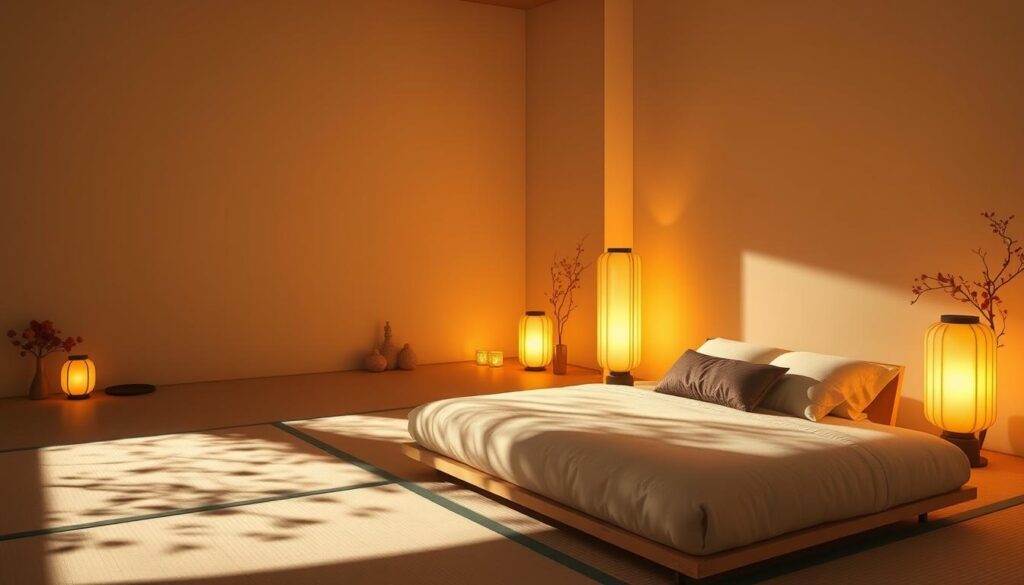
Japanese lanterns add authentic style to your lighting design. Hang paper lanterns from the ceiling or place them on side tables. They provide soft light and enhance the overall look.
For a modern touch, use LED strip lights behind furniture or along the daybed edges. This creates a subtle backlight effect, adding depth to the room. Aim for adjustable light layers.
Combine natural light, ambient lighting, and Japanese lanterns for a harmonious and inviting space. This approach enhances functionality and creates a peaceful environment.
Accessorizing Your Japanese Daybed Room
Your Japanese daybed room is a canvas for minimalist decor. Create a space that’s both functional and serene. Let’s explore how to add perfect touches to your room.
Essential Decorative Elements
Japanese-inspired accessories are the heart of your room’s decor. Choose items that blend simplicity with elegance.
- Ceramic vases with clean lines
- Woven bamboo baskets for storage
- Simple wall scrolls or prints
- Low, wooden side tables
Storage Solutions
Smart storage keeps your space clutter-free. Consider these options:
- Built-in drawers under the daybed
- Floating shelves for books and small items
- Woven baskets for blankets and pillows
- Slim, vertical cabinets for larger items
Plant Integration
Indoor plants bring life to your Japanese daybed room. They purify the air and add a touch of nature. Try these ideas:
- Place a bonsai tree on a low table
- Hang a kokedama (moss ball plant) near a window
- Use bamboo plants as room dividers
- Add a small zen garden with pebbles and miniature plants
In Japanese design, less is more. Pick a few key pieces that speak to you. Let them shine in your peaceful space.
Maintaining Authenticity While Embracing Modern Elements
Modern Japanese design blends tradition and innovation. It fuses cultural elements with contemporary interiors. This approach balances authenticity and practicality in home spaces.
Blending Traditional and Contemporary Features
Add traditional Japanese elements to your modern space. Here are some ideas:
- Use tatami mats as flooring or area rugs
- Install shoji doors for privacy and natural light
- Add low-profile furniture to create a grounded feel
- Choose a neutral color palette for a serene atmosphere
Adapting Japanese Design for Western Homes
You can adapt Japanese design principles for Western homes. Try these approaches:
- Use natural materials like wood, bamboo, and stone
- Embrace the wabi-sabi philosophy of imperfect beauty
- Create open floor plans for a sense of spaciousness
- Incorporate handcrafted objects for warmth and character
Blend traditional Japanese elements with modern features. This creates a unique living space. Your home will reflect Japanese culture and contemporary style.
This modern Japanese design approach offers the best of both worlds. It results in a personalized environment you’ll love.
Creating Multi-functional Spaces with Japanese Daybeds
Japanese daybeds blend style and function perfectly. They turn spaces into cozy seating or comfy sleeping spots. These versatile pieces maximize living areas, especially in smaller homes.
Space-saving is key in Japanese daybed design. Many models have hidden storage or pull-out desks. This clever design keeps rooms clutter-free while providing needed functionality.
- Choose neutral colors like white, beige, or gray to create a calming backdrop
- Incorporate natural materials such as wood or bamboo for an authentic feel
- Add textural elements to create visual interest
- Use modular furniture pieces that can be easily rearranged
- Integrate smart storage solutions to keep the space organized
Japanese daybeds create adaptable interiors for various uses. They can be a quiet workspace or cozy reading nook. These daybeds also serve as extra beds for guests.
A well-designed Japanese daybed room meets many needs. It maintains a serene and stylish atmosphere throughout the day.
Conclusion
Japanese-inspired interiors create serene living spaces. They blend modern minimalism with timeless elegance. The Japandi daybed style combines Japanese and Scandinavian design elements.
Daybed modern style japanese feature clean lines and natural materials. They serve multiple purposes in your home. These versatile pieces embody functionality and style.
Solid wood frames and organic textiles add visual interest. Neutral color palettes transform your living area into a peaceful retreat. These elements foster a deep connection with nature.
Japanese-inspired interiors balance form and function. Vertical wood slats and curved room dividers contribute to a harmonious environment. Natural materials create a clutter-free space.
By using these design principles, you’ll craft a visually appealing home. Your space will promote calm and well-being. Enjoy the tranquility of your Japanese-inspired interior.



